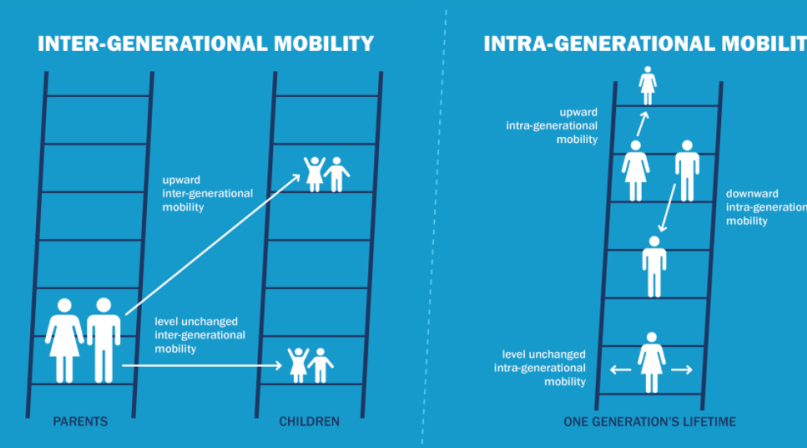NACo examines county role in economic mobility
Author
Upcoming Events
Related News

Key Takeaways
The phrase “economic mobility” evokes pithy responses from a range of perspectives. Many consider it to mean wealth, education and opportunity, while for others, a more nuanced illustration comes to mind of systems, environment or generations. In academia, economic mobility generally refers to changes in people’s economic outcomes or status over a lifetime or across generations — usually measured in income.
Economic mobility is a multi-faceted concept encompassing inter-generational mobility (comparing an individual’s income as an adult relative to their parent’s or grandparent’s income) and intra-generational mobility (changes in an individual’s income over their life). Inter-and intra-generational mobility is measured based on absolute or relative differences. Absolute mobility examines individuals’ upward and downward changes over time, while relative mobility examines how individuals rank in the income distribution over their lifetime compared to their peers.
Learn more
In the United States, absolute mobility has fallen over time, while relative mobility has remained constant. Furthermore, there are significant and persistent gaps in socioeconomic outcomes (i.e., opportunity, education, income and wealth) across racial and ethnic groups.
These inequities in mobility present an opportunity for counties seeking to effect change within their communities.
The county role in economic mobility is often glossed over or lost entirely. However, for NACo’s Economic Mobility Leadership Network (EMLN), the county role in mobility has never been more apparent.
The network is a cohort of county leaders who examine the range of complex issues that comprise economic mobility, including housing and food insecurity and an overall lack of opportunity.
In 2019, NACo began working on a report inspired and shaped by members of the network to examine the county role and authority in inducing mobility and highlight best practice solutions from across the country. Drawing from a survey of network participants, with grounding in academic literature, NACo deduced seven key issue areas in which county officials can employ levers to foster mobility:
- Housing
- Education and Workforce Development
- Health
- Community and Neighborhood Development
- Justice & Public Safety
- Technology and Information Access
- Financial Security.
Within these seven domains, counties possess the authority to enact policies (e.g., ordinances or resolutions), enact or administer programs (e.g., workforce development training), form partnerships (e.g., a consortium of nonprofit and private partners) or a combination of the three. Because counties have distinct roles and authorities in these seven key factors, county policies and investments are particularly effective solutions to uplift communities and residents and drive upward mobility.
The new NACo report, “County Government Levers to Drive Economic Mobility,” explores these seven issue areas through the lens of county authority and provides tangible, means-tested solutions counties have implemented which cultivate mobility.
The case studies in the report feature members of NACo’s Economic Mobility Leadership Network (EMLN).
.
Attachments
Related News

Counties and Railroads: Shared Priorities for the Next Surface Transportation Bill
County leaders from across the country have a vital opportunity to ensure their infrastructure priorities are front and center.

House reintroduces bipartisan legislation to level playing field for rural communities
House reintroduced the Rural Partnership and Prosperity Act, bipartisan legislation intended to advance economic development in rural counties and overcome barriers to obtaining federal funding and resources.

Podcast: Eastern Tennessee counties invest in tourism during shutdown
Sevier County, Tenn. refused to let the government shutdown devastate its fall tourism draw—Great Smoky Mountains National Park. County Mayor Larry Waters describes the lengths he and his neighbors went to keep the park open. And NACo Chief Government Affairs Officer Mark Ritacco offers an outlook on what counties can take away from the shutdown and into the future.